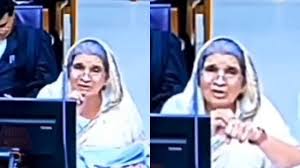A murder and a viral video: Who is Mamta Pathak, former chemistry professor, convicted of killing her husband by electrocution

Criminal cases often capture public attention. Sometimes, the story is not just about the crime but the people involved. One such case is that of Mamta Pathak, a former chemistry professor from Madhya Pradesh. She was convicted of murdering her husband, Dr. Neeraj Pathak. What makes this case unique is the viral courtroom moment where Mamta used her scientific knowledge to defend herself.
The Tragic Incident
On April 29, 2021, Dr. Neeraj Pathak was found dead in their home in Chhatarpur, Madhya Pradesh. The autopsy report stated electrocution as the cause of death. This shocked the local community. Mamta Pathak, his wife and a respected academic, was arrested soon after and charged with murder.
The prosecution based their case mainly on circumstantial evidence. They cited conflicts in the marriage and statements from relatives. A key piece of evidence was a distressing phone call. Hours before his death, Dr. Neeraj called a family member. He claimed Mamta was confining him and mistreating him. This call raised suspicions about her motive.
The Court Battle Begins
Mamta’s trial attracted media attention. Unlike most defendants, she chose to represent herself during her appeal. Her background as a chemistry professor soon became important.
She challenged the prosecution’s claim about the cause of death. Mamta argued the autopsy was flawed. She said the report relied on visual inspection alone. According to her, true proof of electrocution requires chemical analysis of tissues. This analysis can distinguish electric burns from other injuries.
The Viral Courtroom Moment
In 2025, during a hearing in the Madhya Pradesh High Court, Mamta explained the science behind electrocution injuries. She described how electric currents affect human tissues at a cellular level. She pointed out that thermal burns and electric burns can look similar but differ chemically.
Her explanation surprised the judges. One asked, “Are you a chemistry professor?” Mamta calmly replied, “Yes.” The courtroom video of this moment quickly went viral.
People praised her calmness and intelligence. Many said the scene reminded them of TV shows like Breaking Bad, where science and crime mix. The video spread widely on social media, making Mamta an unexpected public figure.
Public Reaction and Media Coverage
The video sparked mixed reactions. Supporters admired her courage and knowledge. They saw her as a woman standing up for herself in a tough legal fight. Critics remained doubtful, saying her science did not disprove other evidence against her.
News outlets covered the case in detail. Experts debated the role of forensic science in legal trials. Some argued this case showed the need for more scientific rigor in criminal investigations.
Current Status and Implications
As of mid-2025, Mamta remains out on bail. The High Court has heard her arguments and is yet to give a verdict. This case may set important legal precedents. It highlights how expert knowledge can influence criminal trials. It also stresses the importance of proper forensic evidence.
Mamta’s story symbolizes the power of knowledge and calm thinking. It also raises questions about how women face the justice system, especially when accused of serious crimes.
Who is Mamta Pathak?
Mamta Pathak spent many years as a chemistry professor at a college in Madhya Pradesh. She was known for her dedication and deep knowledge. Her life was mostly quiet until the tragic incident. Now, her academic skills have become key in her legal defense.
Her case has sparked discussions about marital pressures and domestic crime investigations. While the final verdict is awaited, Mamta’s courtroom defense shows the complex mix of law, science, and human experience.
Conclusion
The death of Dr. Neeraj Pathak and Mamta Pathak’s conviction is a tragic story with many layers. It reveals how knowledge and science play crucial roles in legal cases. Mamta’s viral courtroom moment showed her intelligence and calm under pressure.
Her story is a reminder that truth in criminal cases is often complex. It also shows how courage and expertise can challenge assumptions. As the court prepares its final judgment, many watch closely, fascinated by this unusual blend of science and justice.






